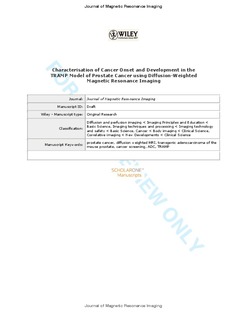Diffusion-weighted MRI for early detection and characterization of prostate cancer in the transgenic adenocarcinoma of the mouse prostate model
Hill, Deborah Katherine; Kim, Eugene; Teruel, Jose Ramon; Jamin, Yann; Widerøe, Marius; Søgaard, Caroline Danielsen; Størkersen, Øystein; Nava Rodriguez, Daniel; Heindl, Andreas; Yuan, Yinyin; Bathen, Tone Frost; Moestue, Siver Andreas
Abstract
Purpose
To improve early diagnosis of prostate cancer to aid clinical decision-making. Diffusion-weighted magnetic resonance imaging (DW-MRI) is sensitive to water diffusion throughout tissues, which correlates with Gleason score, a histological measure of prostate cancer aggressiveness. In this study the ability of DW-MRI to detect prostate cancer onset and development was evaluated in transgenic adenocarcinoma of the mouse prostate (TRAMP) mice.
Materials and Methods
T2-weighted and DW-MRI were acquired using a 7T MR scanner, 200 mm bore diameter; 10 TRAMP and 6 C57BL/6 control mice were scanned every 4 weeks from 8 weeks of age until sacrifice at 28–30 weeks. After sacrifice, the genitourinary tract was excised and sectioned for histological analysis. Histology slides registered with DW-MR images allowed for validation of DW-MR images and the apparent diffusion coefficient (ADC) as tools for cancer detection and disease stratification. An automated early assessment tool based on ADC threshold values was developed to aid cancer detection and progression monitoring.
Results
The ADC differentiated between control prostate ((1.86 ± 0.20) × 10−3 mm2/s) and normal TRAMP prostate ((1.38 ± 0.10) × 10−3 mm2/s) (P = 0.0001), between TRAMP prostate and well-differentiated cancer ((0.93 ± 0.18) × 10−3 mm2/s) (P = 0.0006), and between well-differentiated cancer and poorly differentiated cancer ((0.63 ± 0.06) × 10−3 mm2/s) (P = 0.02).
Conclusion
DW-MRI is a tool for early detection of cancer, and discrimination between cancer stages in the TRAMP model. The incorporation of DW-MRI-based prostate cancer stratification and monitoring could increase the accuracy of preclinical trials using TRAMP mice. J. Magn. Reson. Imaging 2016;43:1207–1217.
